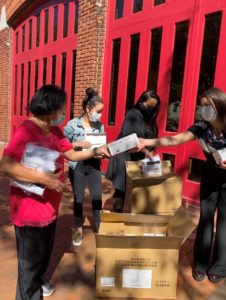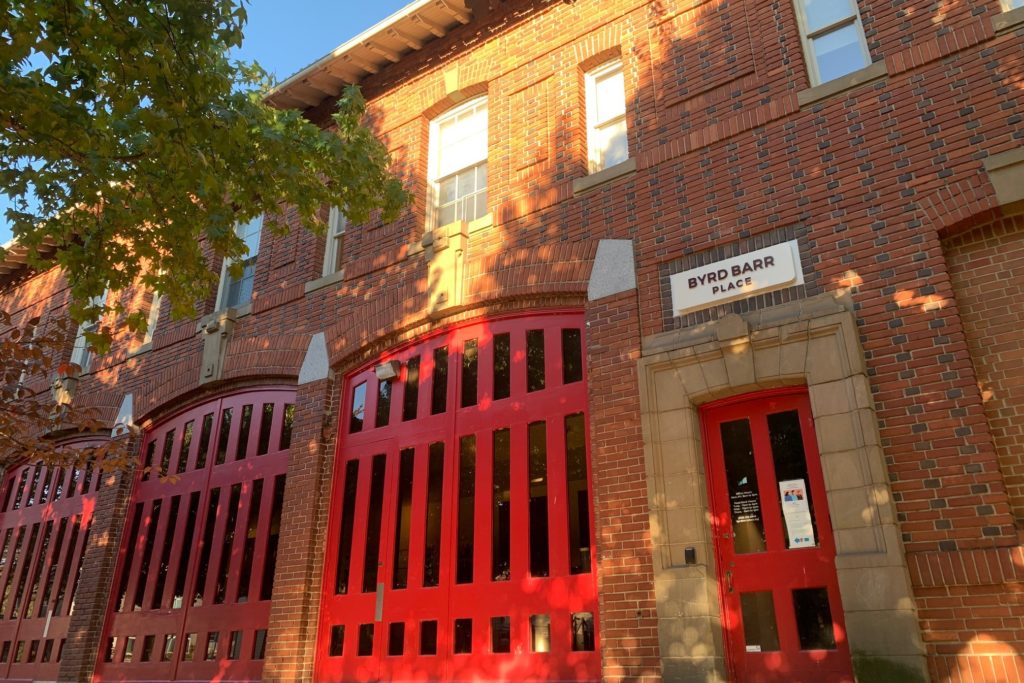We sat down with Meredith Sibley of Byrd Barr Place (BBP) for a Q&A about our organizations’ respective work and how it has interacted over the years.

What is Byrd Barr Place?
Formerly the Central Area Motivation Program, we are one of Washington’s oldest community organizations, founded in the era of the Economic Opportunity Act of 1964. In 1979, we joined the Washington State Community Action Program, a network of 31 agencies in 39 counties that has partnered to improve the lives of low-income people throughout the state. Byrd Barr Place supports Seattle with a mission to fight against the effects of racism and segregation.
Since 1964, BBP has been instrumental in combating poverty throughout the Greater Seattle region, supporting basic needs, providing education and assistance, and advocating for a more equitable place for all residents to live and thrive. Our programs include housing and energy assistance, a food bank, and personal finance resources, with special attention given to emergency situations, such as power shutoff and eviction. Our clients come from all parts of the city, with varied social, cultural, and ethnic backgrounds. They include refugees and immigrants, the elderly and the disabled. Most live at 150% or more below the federal poverty level.
Today our organization connects more than 15,000 Seattle residents with basic human services, encourages development projects that help keep households in the Central District, and creates opportunities for displaced residents and families to return. In the wake of COVID-19, we are providing a lifeline to our community members by responding to the devastating effects of immediate crises and addressing the systemic inequities exposed by the pandemic.
How would you describe the purpose of Byrd Barr Place?
Byrd Barr Place nurtures a more equitable Seattle through programs and advocacy that enable people to live healthier, prosperous lives. Our programs help Seattle residents with basic human services — a warm home, food on the table, and immediate financial relief — so they can break the cycle of poverty and build self-sufficiency.

We have a two-pronged approach to the problem of poverty. We try to approach our direct services by meeting clients where they are and offering them a solution to whatever problem they are experiencing. Then we also have proprietary research reports that are really about understanding root causes and making upstream change. So Byrd Barr Place has this almost unrecognized, silent but steady approach in our community engagement, where we are trying to influence policy change, or trying to make higher-level change that can then make an impact on how many people are in situations of poverty or are in a crisis or emergency and need to seek our services out. So, yes, Byrd Barr Place is at its core a direct services agency because we’re a community action agency. However, Andrea Caupain, CEO of Byrd Barr Place, has really focused on how to have an impact that’s broader than just meeting someone in that moment.
As we have since our inception, we continue to raise awareness of the effects of racism and inequity on the Black community and to advocate for solutions that will create a more equitable future for all Washingtonians. As an important part of these efforts, Byrd Barr Place leads the Seattle Community of Practice, a collaboration of community organizations working to address specific challenges and opportunities for African Americans, including access to (and quality of) education, housing, jobs and health care.
How did Byrd Barr Place come to partner with Community Roots Housing?
Byrd Barr Place and Community Roots Housing have been close to each other in Seattle for a long time. There’s been a lot of research referral between our two agencies; Community Roots residents have sought services at our agency, and we’ve certainly referred folks to your affordable housing buildings. So there’s a really mutually beneficial relationship between the two organizations, a common mission. And now, the Rise Together project is an amplification of that, where we’re looking at having a bigger impact on like communities and place keeping.
In 2016, Byrd Barr Place played a significant role in the community development meetings that led to the successful completion of the Liberty Bank Building. BBP helped broker relationships across communities and organizations in the Liberty Bank Building Development, resulting in a ground-breaking Memorandum of Understanding among the project partners – Africatown, Black Community Impact Alliance, and Community Roots Housing – defining a truly equitable mixed-use affordable housing development on a site with enormous historical significance to the African American community.
How has the pandemic affected your operations and the services you offer?
During normal operating times, the BBP food bank resembles a grocery store where clients choose from displays stocked with healthy foods and non-grocery

essentials. Our food bank has remained open during the pandemic, however to minimize the risk of exposure for our clients and volunteers, we have moved food distribution outdoors by setting up tents and creating a small market. We distribute food four days a week, Tuesday through Thursday on site, and Fridays we deliver food to several partner organizations around the city and run our home grocery delivery program to reach more of those most vulnerable, including seniors with chronic conditions or families with very young children. We have seen the number of visits to our food bank rise since the start of the pandemic and are now serving close to 1,000 households each week. We buy fresh vegetables directly from small local farms in Washington to ensure we are providing healthy and fresh produce for our clients. We also support the Seattle Public School Backpack brigade program to ensure students at home are still receiving three square meals each day. We have invested in technology and moved our Energy and Rental assistance programs online, building online applications so that clients may safely apply remotely.
Tell me about the journey of the Byrd Barr Place firehouse.
Byrd Barr Place has been based at the historic Fire Station 23 in Seattle’s Central District since February 1968 when our previous office on 17th and Union was firebombed during the height of Seattle’s civil rights movement. The City of Seattle leased the firehouse to BBP under a Mutual and Offsetting Benefit agreement, which counted the value of the human services we provided as rent. Our organization has operated and maintained the facility since that time. Fire Station 23 has been our home for more than five decades, and much has happened inside those brick walls; hundreds of community gatherings have been hosted, holiday parties, BBQs, community meetings, workshops, theater classes, and performances like African Drum circles. In 2010 the leadership of Byrd Barr Place requested that the City consider transferring ownership to the agency rather than continue our month-to-month lease. This started a decade-long process of advocating to turn ownership of this landmark building over to Byrd Barr Place. On September 19, 2020 the City Council voted ‘yes.’ We are over the moon, and we are committed to stewarding this property for the next 50 years in service to our community.
What does it mean to your organization to own this place?
As an anchor of the Black community in its historic neighborhood of the Central District, the building is much more than a historic landmark; along with a few other precious community-owned resources, it is a symbol of the Black community’s place in Seattle. Byrd Barr Place has been providing safety net services for over 56 years — services such as food, energy, housing assistance, homelessness prevention, home repair, and personal finance. Fire Station 23 holds empowerment that reflects the legacy of the Black experience in Seattle. This building is not only a means to create economic mobility for Black people, but for all of our vulnerable families and individuals in Seattle.
In addition to ensuring that services for low-income people in Seattle continue uninterrupted, an additional public benefit of this project is the provision of meeting room space for community members, which will be free or extremely low cost during BBP hours of operation, as well as nights and weekends. The meeting space can be used for film viewings, community meetings, educational lectures, classroom sessions, art programs, and more. There is currently a lack of large meeting space available to the public in the Central District, so improving this space will be addressing a neighborhood need. The current and continued community benefit to this project is that we convene a mix of activities to serve diverse groups of people.
What is the vision for the firehouse?
BBP envisions Fire Station 23 as a welcoming, accessible, highly functional, community-owned anchor in which to pursue its comprehensive equity agenda. New building systems will increase energy efficiency, decrease the building’s carbon footprint, and extend its useful life for decades to come. A reconfigured interior will allow BBP to serve more people more effectively, and create new, no- or low-cost meeting space for the community. BBP will finally be able to address the building’s inaccessibility for people with disabilities. BBP very much looks forward to having elevator access to the second floor and redesigning the staircase, which is currently 23 consecutive steps without a landing and difficult for many people to climb. Seismic safety improvements will reduce the risk to life and health and protect this important community asset in the event of a significant earthquake. A redesigned food bank will enhance client experience and increase the food distribution capabilities, while also improving as our ability to connect with clients to make resource referrals to propel their health and well-being forward. New site-specific art will make visible BBP’s contribution to Seattle’s diverse cultures, while its historic elements are preserved.
Tell me about Byrd Barr Place’s community engagement work.
Although we are best known for our long history of direct service provision, BBP has often acted as a convener of Black-led organizations, participated in multi-organization collaborations, or found ways to support other Black-led organizations in service to the advancement of the Black community across Washington State.
In 2018, BBP participated in the planning and implementation of the Delta Vision project, an exciting collaboration among King County communities of color to reframe capacity building to meet our needs, to encompass the roles and responsibilities of funders and policy makers in shaping our organizations, and to explicitly address racial equity, systems, and power in capacity building work. This convening is known as the Delta Model, a collaborative project among Byrd Barr Place, The Center for Ethical Leadership, Latino Community Fund, Potlatch Fund, Rainier Valley Corps, and Communities Rise. The Delta Model led an initiative to develop a capacity building model for communities of color nonprofit organizations and their constituents, so that we can more effectively participate in civic engagement and advocacy around critical areas such as safety net services, environmental justice and education equity.
How can readers help support Byrd Barr Place and the vital work it engages in?
The best way to support Byrd Barr Place and further our mission is through advocacy and furthering the conversation around equity and justice. Read our published reports and share them with your friends. Start conversations and look within your own organizations for how to combat white supremacy and bring more Black, Indigenous, and People of Color to the table where decision making happens.

